Intelligent Identification of Cavitation State of Centrifugal Pump Based on Support Vector Machine
Abstract
:1. Introduction
2. Experimental Steps
Model Pump Parameters
3. Signal Analysis and Feature Extraction
3.1. Time Domain Feature Extraction
- (1)
- Mean value
- (2)
- Standard deviation
- (3)
- Peak factor
- (4)
- Kurtosis factor
- (5)
- Skewness factor
3.2. Frequency Domain Feature Extraction
- (1)
- Center of gravity frequency
- (2)
- Mean square frequency
- (3)
- Frequency variance
3.3. Time Frequency Domain Feature Extraction
4. Intelligent Recognition of Cavitation States Based on Support Vector Machines
4.1. The Theory of Support Vector Machines
4.2. Support Vector Machine-Based Binary Classification
4.3. Support Vector Machine-Based Multiclassification
5. Conclusions
- The overall temperature has little effect on the cavitation recognition rate and is related to the criteria used to determine the state in which cavitation occurs; the location of the monitoring point has an effect on the accuracy of the monitoring, which is related to the direction of the vibration and the location of the monitoring at the same monitoring point.
- In dichotomous classification, the recognition accuracy of individual feature values was highest for time domain signals, followed by time frequency-domain and finally frequency-domain signals, which was related to the extracted feature values; in multi-classification, the individual feature values were combined to improve the recognition accuracy and the highest recognition rate was found for time domain signals, followed by time frequency-domain signals and finally frequency-domain signals.
- In order to improve the recognition accuracy of multiple classification, the combination of the feature values of the time domain signal at the four monitoring points and the time and frequency domain signal at the monitoring points in the X and Y-directions of the inlet pipe can effectively improve the recognition accuracy, which can reach 100% recognition at a maximum accuracy of 70 °C.
- In terms of recognition accuracy, the intelligent recognition of the cavitation status of centrifugal pumps based on support vector machines can better identify whether cavitation has occurred and the cavitation status.
Author Contributions
Funding
Data Availability Statement
Acknowledgments
Conflicts of Interest
References
- Roland, L.; Gerhard, R. Cavitation research at the Institute of Hydraulic Engineering and Water Resources Management. In Proceedings of the International Conference on Hydrodynamics, Wuxi, China, 30 October–3 November 1994; pp. 263–271. [Google Scholar]
- Laborde, R.; Chantrel, P.; Mory, M. Tip clearance and tip vortex cavitation in an axial flow pump. J. Fluids Eng. 1997, 119, 680–685. [Google Scholar] [CrossRef]
- Oba, R.; Yasu, S. Spatial cavitation-nuclei measurement by means of laser velocimeter. Rep. Inst. High Speed Mech. 1978, 310, 47–54. [Google Scholar]
- Tabar, M.T.S.; Poursharifi, Z. An experimental study of tip vortex cavitation inception in an axial flow pump. Int. J. Mech. Mechatron. Eng. 2011, 5, 86–89. [Google Scholar]
- Farhat, M.; Bourdon, P.; Gagne, J.; Remillard, L. Improving hydro turbine profitability by monitoring cavitation aggressiveness. In Proceedings of the CEA Electricity 99 Conference and Exposition, Vancouver, BC, Canada, 29–31 March 1999. [Google Scholar]
- Xue, H.; Li, K.; Wang, H.; Chen, P. Sequential Diagnosis Method for Rotating Machinery Using Support Vector Machines and Possibility Theory. In Proceedings of the International Conference on Intelligent Computing, Nanning, China, 28–31 July 2013; Springer: Berlin/Heidelberg, Germany, 2013. [Google Scholar]
- McKee, K.K.; Forbes, G.L.; Mazhar, I.; Entwistle, R.; Hodkiewicz, M.; Howard, I. A vibration cavitation sensitivity parameter based on spectral and statistical methods. Expert Syst. Appl. 2015, 42, 67–78. [Google Scholar] [CrossRef] [Green Version]
- Azizi, R.; Attaran, B.; Hajnayeb, A.; Ghanbarzadeh, A.; Changizian, M. Improving accuracy of cavitation severity detection in centrifugal pumps using a hybrid feature selection technique. Measurement 2017, 108, 9–17. [Google Scholar] [CrossRef]
- Giorgi, M.G.; Bello, D.; Ficarella, A. An artificial neural network approach to investigate cavitating flow regime at different temperatures. Measurement 2014, 47, 971–981. [Google Scholar] [CrossRef]
- Giorgi, M.G.; Ficarella, A.; Lay-Ekuakille, A. Cavitation Regime Detection by LS-SVM and ANN with Wavelet Decomposition Based on Pressure Sensor Signals. IEEE Sens. J. 2015, 15, 5701–5708. [Google Scholar] [CrossRef]
- Sun, H.; Si, Q.; Chen, N.; Yuan, S. HHT-based feature extraction of pump operation instability under cavitation conditions through motor current signal analysis. Mech. Syst. Signal Process. 2020, 139, 106613. [Google Scholar] [CrossRef]
- Yang, B.S.; Hwang, W.W.; Ko, M.H.; Lee, S.-J. Cavitation detection of butterfly valve using support vector machines. J. Sound Vib. 2005, 287, 25–43. [Google Scholar] [CrossRef]
- Cao, Y.; Ming, Y.; He, G.; Su, Y. Cavitation state recognition of centrifugal pumps based on deep learning. J. Xi’an Jiaotong Univ. 2017, 51, 165–172. [Google Scholar]
- Ge, M.; Petkovšek, M.; Zhang, G.; Jacobs, D.; Coutier-Delgosha, O. Cavitation dynamics and thermodynamic effects at elevated temperatures in a small Venturi channel. Int. J. Heat Mass Transf. 2021, 170, 120970. [Google Scholar] [CrossRef]
- Ge, M.; Zhang, G.; Petkovšek, M.; Long, K.; Coutier-Delgosha, O. Intensity and regimes changing of hydrodynamic cavitation considering temperature effects. J. Clean. Prod. 2022, 338, 130470. [Google Scholar] [CrossRef]
- Ge, M.; Sun, C.; Zhang, G.; Coutier-Delgosha, O.; Fan, D. Combined suppression effects on hydrodynamic cavitation performance in Venturi-type reactor for process intensification. Ultrason. Sonochem. 2022, 86, 106035. [Google Scholar] [CrossRef]
- Ge, M.; Manikkam, P.; Ghossein, J.; Subramanian, R.K.; Coutier-Delgosha, O.; Zhang, G. Dynamic mode decomposition to classify cavitating flow regimes induced by thermodynamic effects. Energy 2022, 254, 124426. [Google Scholar] [CrossRef]
- Wu, K.; Ali, A.; Feng, C.; Si, Q.; Chen, Q.; Shen, C. Numerical Study on the Cavitation Characteristics of Micro Automotive Electronic Pumps under Thermodynamic Effect. Micromachines 2022, 13, 1063. [Google Scholar] [CrossRef]
- Wang, H.; Chen, P. Intelligent diagnosis method for a centrifugal pump using features of vibration signals. Neural Comput. Appl. 2009, 18, 397–405. [Google Scholar] [CrossRef]
- Ali, A.; Si, Q.; Wang, B.; Yuan, J.; Wang, P.; Rasool, G.; Shokrian, A.; Ali, A.; Zaman, M.A. Comparison of empirical models using experimental results of electrical submersible pump under two-phase flow: Numerical and empirical model validation. Phys. Scr. 2022, 97, 065209. [Google Scholar] [CrossRef]
- Qiaorui, S.; Ali, A.; Biaobiao, W.; Wang, P.; Bois, G.; Jianping, Y.; Kubar, A.A. Numerical Study on Gas-Liquid Two Phase Flow Characteristic of Multistage Electrical Submersible Pump by Using a Novel Multiple-Size Group (MUSIG) Model. Phys. Fluids 2022, 34, 063311. [Google Scholar] [CrossRef]
- Ali, A.; Yuan, J.; Deng, F.; Wang, B.; Liu, L.; Si, Q.; Buttar, N. Research Progress and Prospects of Multi-Stage Centrifugal Pump Capability for Handling Gas–Liquid Multiphase Flow: Comparison and Empirical Model Validation. Energies 2021, 14, 896. [Google Scholar] [CrossRef]
- Ali, A.; Si, Q.; Yuan, J.; Shen, C.; Cao, R.; AlGarni, T.S.; Awais, M.; Aslam, B. Investigation of energy performance, internal flow and noise characteristics of miniature drainage pump under water–air multiphase flow: Design and part load conditions. Int. J. Environ. Sci. Technol. 2022, 19, 7661–7678. [Google Scholar] [CrossRef]
- Zhang, L.Q.; Zhu, L.M.; Zhong, B.L. Study on the features of some specific parameters utilized for machine condition monitoring. Chin. J. Vib. Shock. 2001, 20, 20–25. [Google Scholar]
- Shervani-Tabar, M.T.; Ettefagh, M.M.; Lotfan, S.; Safarzadeh, H. Cavitation intensity monitoring in an axial flow pump based on vibration signals using multi-class support vector machine. Proc. Inst. Mech. Eng. Part C J. Mech. Eng. Sci. 2018, 232, 3013–3026. [Google Scholar] [CrossRef]
- Rapur, J.S.; Tiwari, R. Experimental Time-Domain Vibration-Based Fault Diagnosis of Centrifugal Pumps Using Support Vector Machine. ASCE-ASME J. Risk Uncertain. Eng. Syst. Part B Mech. Eng. 2017, 3, 044501. [Google Scholar] [CrossRef]
- Fayed, H.A.; Atiya, A.F. Speed up grid-search for parameter selection of support vector machines. Appl. Soft Comput. 2019, 80, 202–210. [Google Scholar] [CrossRef]
- Hsu, C.W.; Chang, C.C.; Lin, C.J. A Practical Guide to Support Vector Classification. 2003. Available online: https://www.csie.ntu.edu.tw/~cjlin/papers/guide/guide.pdf (accessed on 24 April 2021).
- Lameski, P.; Zdravevski, E.; Mingov, R.; Kulakov, A. SVM Parameter Tuning with Grid Search and Its Impact on Reduction of Model over-Fitting. Rough Sets, Fuzzy Sets, Data Mining, and Granular Computing; Springer: Cham, Switzerland, 2015; pp. 464–474. [Google Scholar]
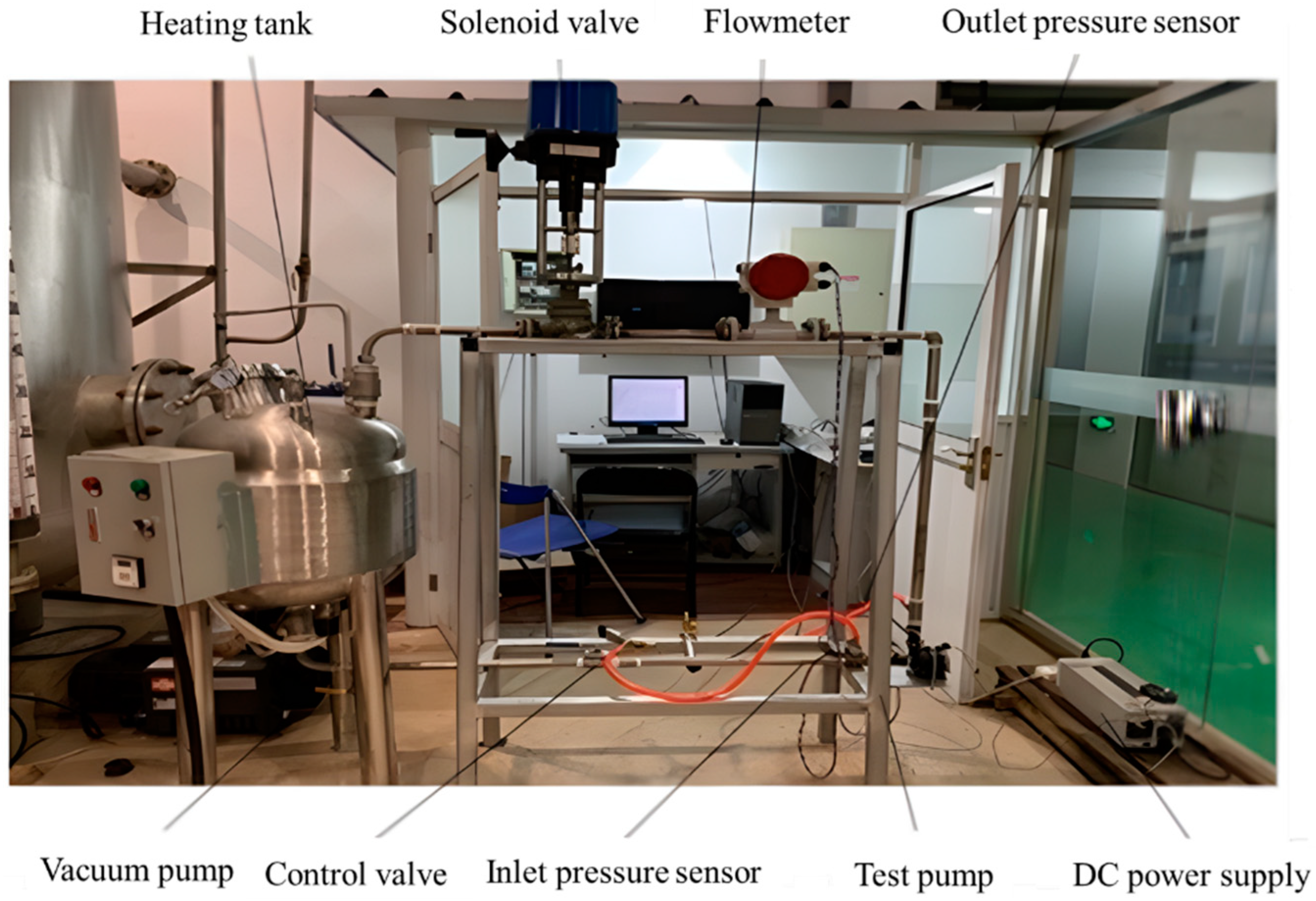
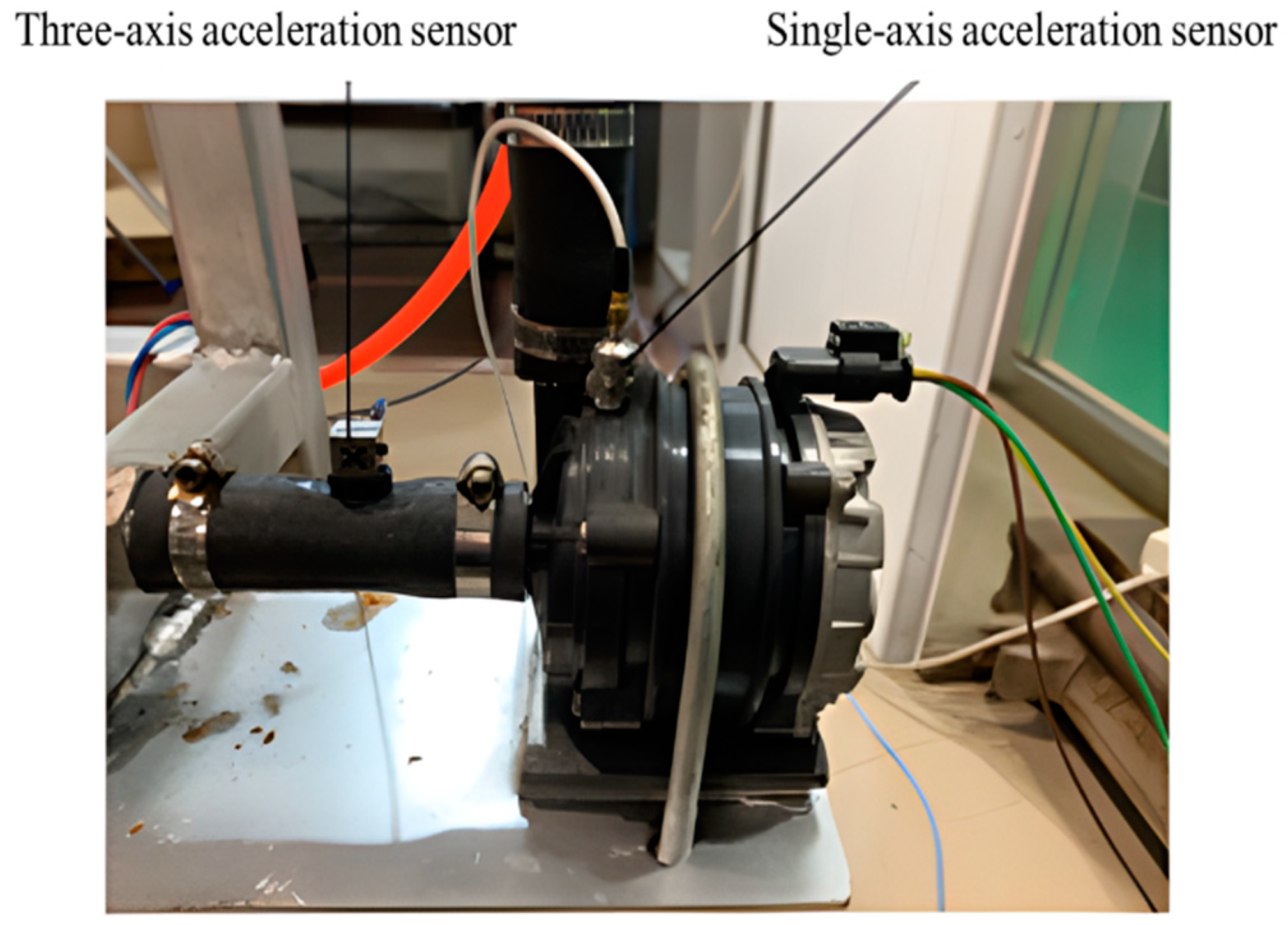

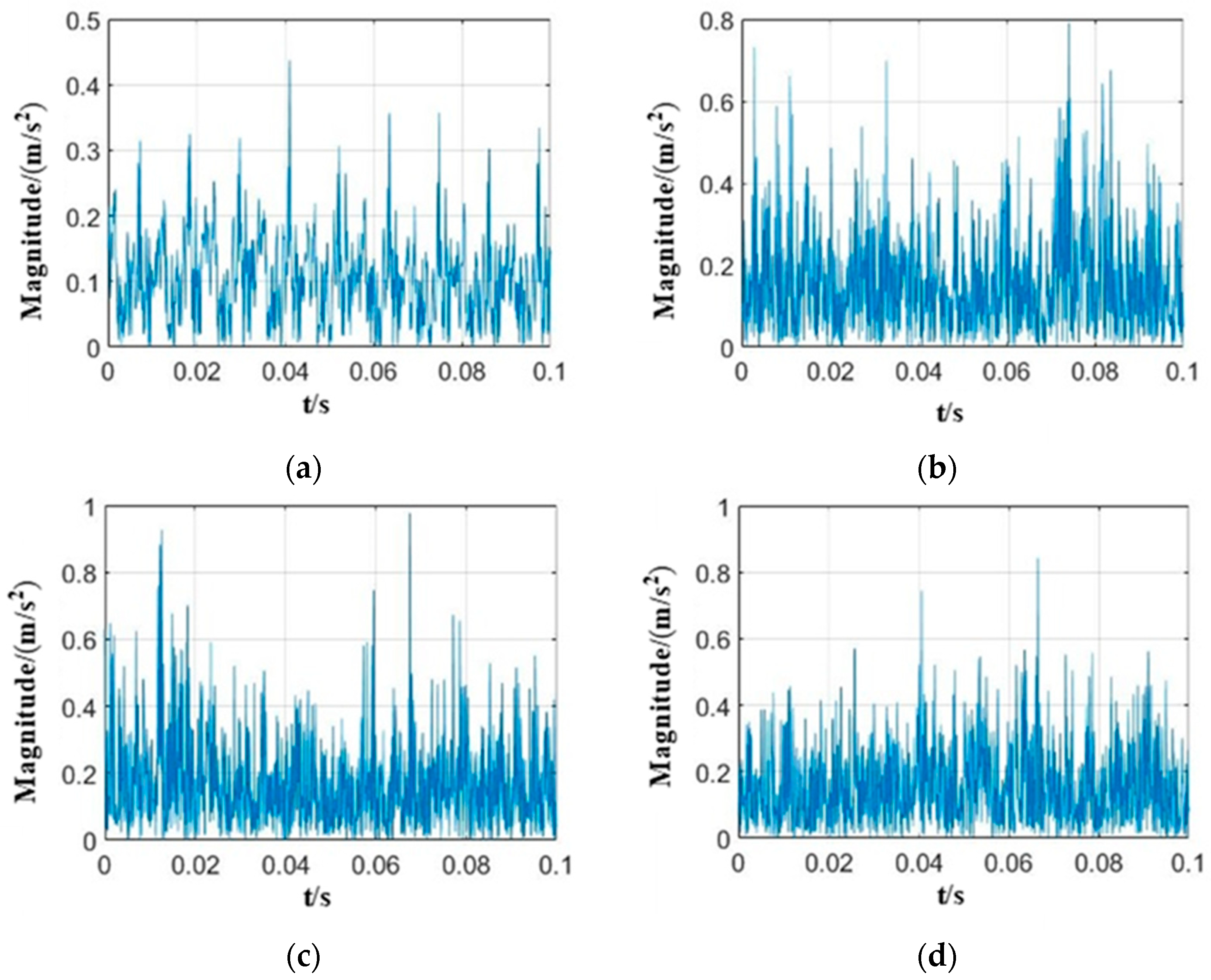
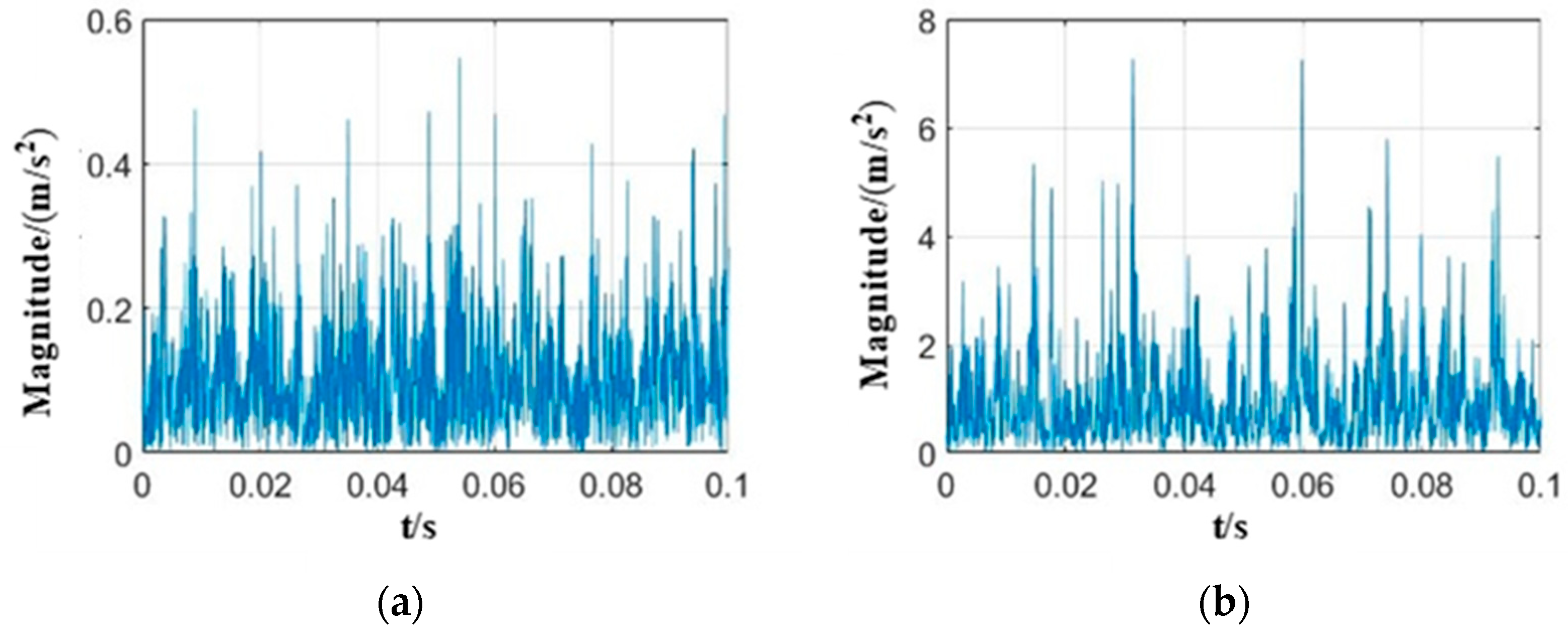
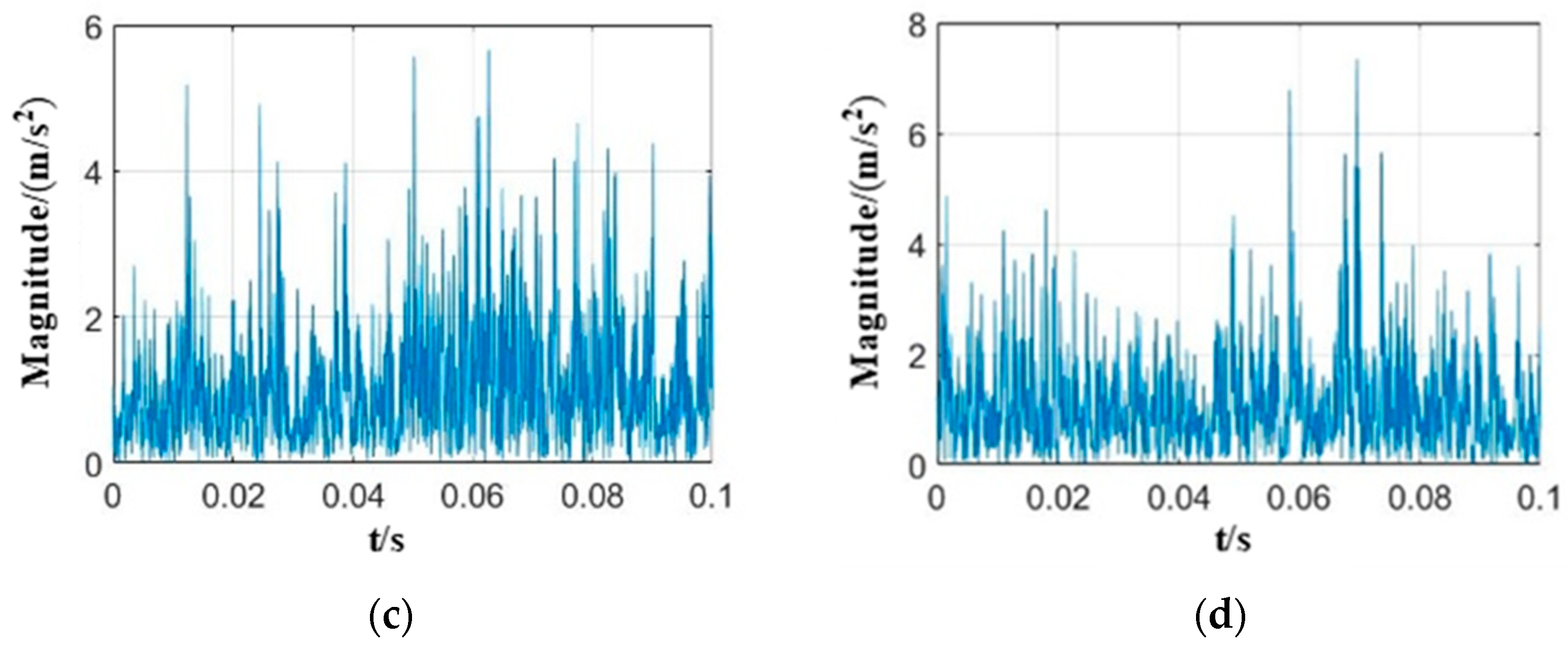

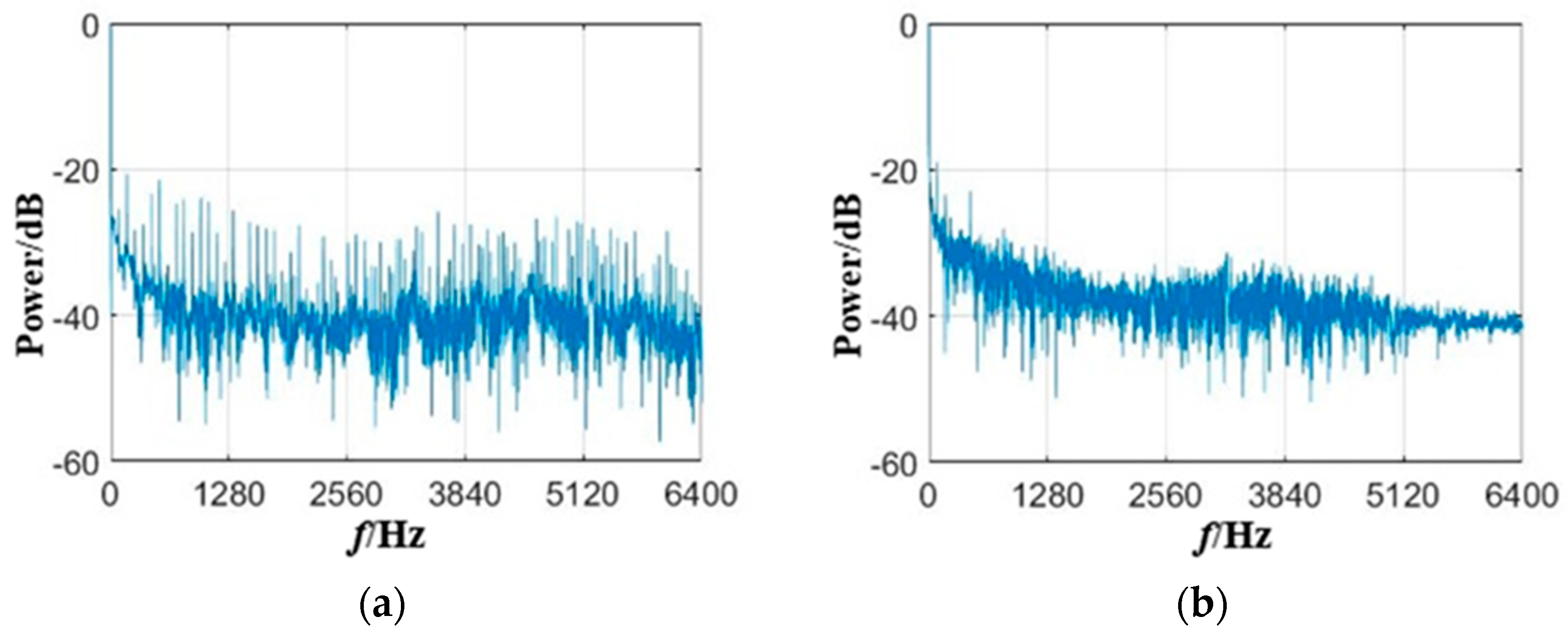

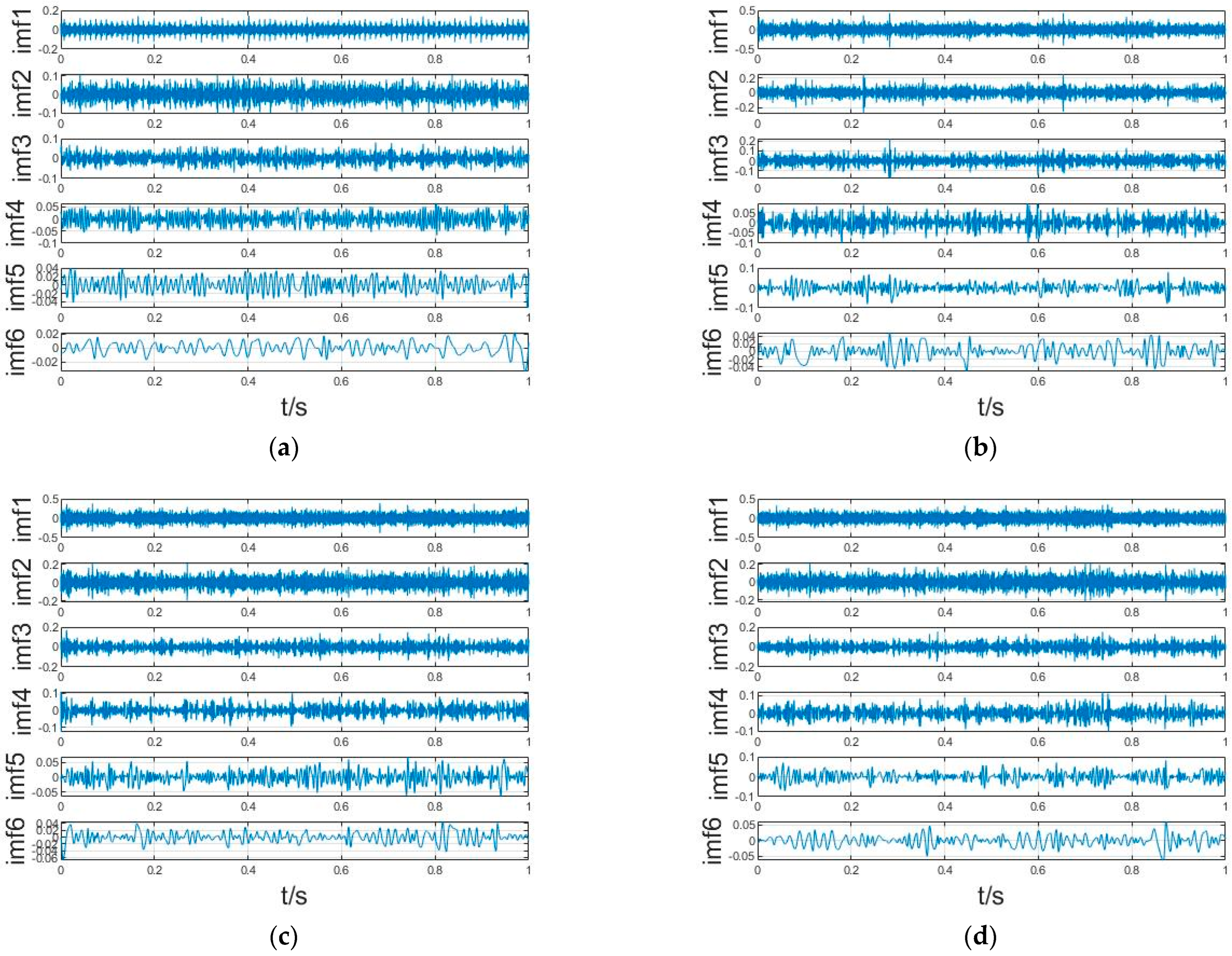
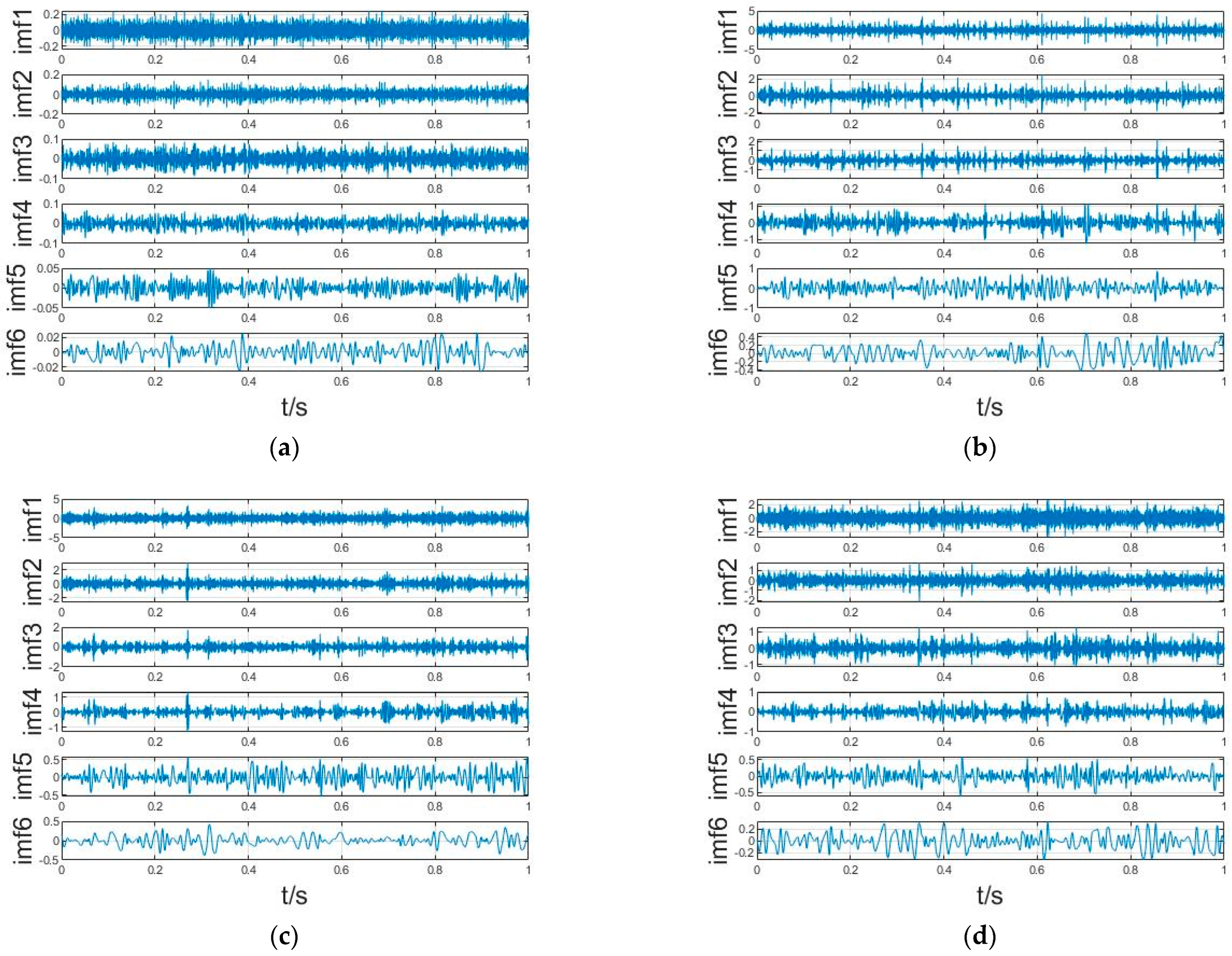

| Recognition Accuracy | |||||
|---|---|---|---|---|---|
| Temperature | Eigenvalue | Inlet Pipe X-Direction | Inlet Pipe Y-Direction | Inlet Pipe Z-Direction | Volute Tongue |
| Mean value | 100% | 100% | 100% | 100% | |
| standard deviation | 100% | 100% | 100% | 100% | |
| 25 °C | Peak factor | 100% | 95% | 98.3333% | 98.3333% |
| Kurtosis factor | 86.6667% | 100% | 100% | 100% | |
| Skewness factor | 100% | 100% | 100% | 100% | |
| Mean value | 100% | 98.3333% | 100% | 100% | |
| standard deviation | 100% | 100% | 100% | 100% | |
| 50 °C | Peak factor | 100% | 96.6667% | 98.3333% | 100% |
| Kurtosis factor | 98.3333% | 100% | 100% | 100% | |
| Skewness factor | 98.3333% | 100% | 100% | 98.3333% | |
| Mean value | 100% | 100% | 100% | 100% | |
| standard deviation | 96.6667% | 100% | 100% | 100% | |
| 70 °C | Peak factor | 100% | 100% | 100% | 98.3333% |
| Kurtosis factor | 100% | 100% | 100% | 65% | |
| Skewness factor | 100% | 100% | 100% | 45% | |
| Recognition Accuracy | |||||
|---|---|---|---|---|---|
| Temperature | Eigenvalue | Inlet Pipe X-Direction | Inlet Pipe Y-Direction | Inlet Pipe Z-Direction | Volute Tongue |
| Center of gravity frequency | 78.3333% | 53.3333% | 76.6667% | 86.6667% | |
| 25 °C | Mean Square Frequency | 75% | 51.6667% | 78.3333% | 86.6667% |
| Frequency variance | 83.3333% | 80% | 65% | 66.6667% | |
| Center of gravity frequency | 46.6667% | 51.6667% | 71.6667% | 80% | |
| 50 °C | Mean Square Frequency | 50% | 48.3333% | 63.3333% | 80% |
| Frequency variance | 85% | 58.3333% | 88.3333% | 60% | |
| Center of gravity frequency | 61.6667% | 53.3333% | 61.6667% | 65% | |
| 70 °C | Mean Square Frequency | 65% | 53.3333% | 65% | 60% |
| Frequency variance | 71.6667% | 63.3333% | 80% | 51.6667% | |
| Recognition Accuracy | |||||
|---|---|---|---|---|---|
| Temperature | Eigenvalue | Inlet Pipe X-Direction | Inlet Pipe Y-Direction | Inlet Pipe Z-Direction | Volute Tongue |
| 25 °C | IMF1 | 100% | 98.3333% | 100% | 100% |
| IMF2 | 100% | 96.6667% | 100% | 96.6667% | |
| IMF3 | 100% | 96.6667% | 88.3333% | 88.3333% | |
| IMF4 | 100% | 95% | 60% | 90% | |
| IMF5 | 100% | 76.6667% | 91.6667% | 96.6667% | |
| IMF6 | 51.6667% | 81.6667% | 98.3333% | 95% | |
| 50 °C | IMF1 | 100% | 100% | 100% | 76.6667% |
| IMF2 | 100% | 100% | 100% | 100% | |
| IMF3 | 91.6667% | 48.3333% | 100% | 100% | |
| IMF4 | 55% | 100% | 100% | 73.3333% | |
| IMF5 | 91.6667% | 100% | 53.3333% | 100% | |
| IMF6 | 66.6667% | 100% | 95% | 63.3333% | |
| 70 °C | IMF1 | 85% | 100% | 96.6667% | 100% |
| IMF2 | 100% | 100% | 93.3333% | 93.3333% | |
| IMF3 | 61.6667% | 100% | 95% | 100% | |
| IMF4 | 98.3333% | 100% | 91.6667% | 100% | |
| IMF5 | 75% | 100% | 73.3333% | 100% | |
| IMF6 | 73.3333% | 100% | 98.3333% | 48.3333% | |
| Recognition Accuracy | ||||
|---|---|---|---|---|
| Temperature | Inlet Pipe X-Direction | Inlet Pipe Y-Direction | Inlet Pipe Z-Direction | Volute Tongue |
| 25 °C | 84.1667% | 92.5% | 86.6667% | 88.3333% |
| 50 °C | 83.3333% | 80% | 85.8333% | 73.3333% |
| 70 °C | 84.1667% | 80.8333% | 80% | 94.1667% |
| Average recognition accuracy | 83.8889% | 84.4444% | 84.1667% | 85.2778% |
| Recognition Accuracy | ||||
|---|---|---|---|---|
| Temperature | Inlet Pipe X-Direction | Inlet Pipe Y-Direction | Inlet Pipe Z-Direction | Volute Tongue |
| 25 °C | 50.8333% | 37.5% | 43.3333% | 40% |
| 50 °C | 43.3333% | 23.3333% | 40.8333% | 33.3333% |
| 70 °C | 36.6667% | 33.3333% | 40.8333% | 35.8333% |
| Average recognition accuracy | 43.6111% | 31.3889% | 41.6666% | 36.3889% |
| Recognition Accuracy | ||||
|---|---|---|---|---|
| Temperature | Inlet Pipe X-Direction | Inlet Pipe Y-Direction | Inlet Pipe Z-Direction | Volute Tongue |
| 25 °C | 85% | 85.8333% | 65.8333% | 87.5% |
| 50 °C | 77.5% | 68.3333% | 75% | 82.5% |
| 70 °C | 75% | 87.5% | 62.5% | 55.8333% |
| Average recognition accuracy | 79.1667% | 80.5555% | 67.7778% | 75.2778% |
| Recognition Accuracy | |||
|---|---|---|---|
| Temperature | 25 °C | 50 °C | 70 °C |
| Recognition accuracy | 94.1667% | 95% | 100% |
Publisher’s Note: MDPI stays neutral with regard to jurisdictional claims in published maps and institutional affiliations. |
© 2022 by the authors. Licensee MDPI, Basel, Switzerland. This article is an open access article distributed under the terms and conditions of the Creative Commons Attribution (CC BY) license (https://creativecommons.org/licenses/by/4.0/).
Share and Cite
He, X.; Song, Y.; Wu, K.; Ali, A.; Shen, C.; Si, Q. Intelligent Identification of Cavitation State of Centrifugal Pump Based on Support Vector Machine. Energies 2022, 15, 8907. https://doi.org/10.3390/en15238907
He X, Song Y, Wu K, Ali A, Shen C, Si Q. Intelligent Identification of Cavitation State of Centrifugal Pump Based on Support Vector Machine. Energies. 2022; 15(23):8907. https://doi.org/10.3390/en15238907
Chicago/Turabian StyleHe, Xiaoke, Yu Song, Kaipeng Wu, Asad Ali, Chunhao Shen, and Qiaorui Si. 2022. "Intelligent Identification of Cavitation State of Centrifugal Pump Based on Support Vector Machine" Energies 15, no. 23: 8907. https://doi.org/10.3390/en15238907







